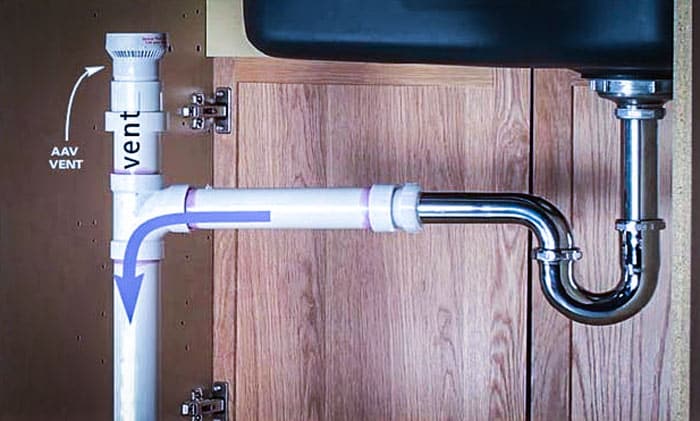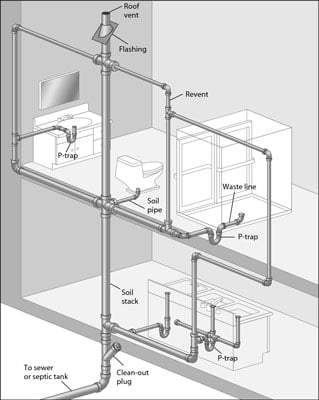The Importance of Ventilation in Building Plumbing Systems
The Importance of Ventilation in Building Plumbing Systems
Blog Article
How do you feel in regards to Why Plumbing Air Vents Are Important?

Proper air flow in plumbing systems is usually overlooked, yet it is important for maintaining the performance and safety and security of your home's plumbing. Ventilation aids regulate air pressure, avoid the accumulation of damaging gases, and make certain the reliable elimination of waste. In this overview, we will check out the significance of appropriate pipes ventilation, how it works, and the benefits it offers your plumbing system.
Comprehending Air Flow in Pipes
Air flow in pipes refers to the network of pipes that enable air to flow with the drain system. These vents offer multiple objectives, consisting of controling air pressure within the pipelines, avoiding drain gases from going into the home, and assisting in the smooth flow of wastewater.
Just How Air Flow Functions in Plumbing Systems
Atmospheric Pressure Policy
Proper ventilation preserves balanced air pressure within the pipes system. When water streams via pipes, it displaces air. Without adequate air flow, this variation can create adverse stress, leading to slow drains or siphoning of water from catches, which can trigger undesirable odors to leak into the home.
Preventing Drain Gas Buildup
Among the most critical features of plumbing vents is to prevent drain gases, such as methane and hydrogen sulfide, from accumulating within the home. These gases can posture significant wellness risks and are highly combustible. Vent pipelines enable these gases to escape securely outside.
Assisting in Waste Removal
Air flow aids in the efficient removal of wastewater by preventing airlocks in the drainage system. When air can move easily with the vents, it enables water and waste to flow efficiently via the pipelines, reducing the risk of clogs and back-ups.
Types of Pipes Vents
Main Stack Vent
The main pile air vent, likewise called the air vent pile, is the key vent in a plumbing system. It expands from the main drain align through the roofing, allowing gases to get away and fresh air to enter the system.
Branch Vent
Branch vents attach to the main stack air vent and serve specific components, such as sinks, bathrooms, and showers. These vents ensure that each fixture has sufficient ventilation to operate properly.
Air Admittance Valve (AAV).
An Air Admittance Valve (AAV) is a one-way valve that allows air to go into the plumbing system without the requirement for a conventional air vent pipeline prolonging via the roofing system. AAVs are generally made use of in restorations or locations where setting up a basic vent is not practical.
Indications of Poor Air Flow in Plumbing.
Slow Draining Fixtures.
If your sinks, bathtubs, or commodes are draining slowly, maybe a sign of bad air flow. Poor air flow can create a vacuum impact, making it hard for water to drain effectively.
Gurgling Appears.
Gurgling sounds originating from drains are commonly an outcome of air being drawn via water catches as a result of adverse stress in the pipelines. This is a clear sign of inadequate ventilation.
Unpleasant Smells.
Drain smells inside your home are a warning that your pipes system is not effectively ventilated. This can suggest that sewer gases are not being properly aired vent outside, bring about potentially unsafe conditions.
Usual Ventilation Mistakes.
Poor Vent Sizing.
Utilizing small vent pipelines can cause inadequate air flow and stress imbalances in the system. It's necessary to make use of vents that meet the particular needs of your plumbing system.
Improper Vent Positioning.
Positioning vents too far from the components they serve can decrease their performance. Proper placement ensures that air can stream openly and successfully through the system.
Ignoring Code Needs.
Building codes offer certain standards for plumbing ventilation. Ignoring these codes can result in a system that fails to operate appropriately and might result in costly repairs or carcinogen.
Advantages of Proper Air Flow.
Boosted System Effectiveness.
Properly aerated plumbing systems run much more efficiently, with less clogs, faster draining pipes, and less stress on the pipelines. This efficiency expands the lifespan of the pipes system.
Improved Air Top Quality.
By stopping sewage system gases from entering your home, correct ventilation adds to better indoor air quality, making your living setting healthier and more comfortable.
Avoiding Water Damage.
Sufficient air flow assists prevent water from being siphoned out of catches, which can cause sewer gases entering the home and causing water damages over time.
Actions to Ensure Appropriate Air Flow.
Consulting Pipes Codes.
Always get in touch with neighborhood plumbing codes when making or customizing your pipes system. These codes provide the necessary guidelines for correct venting and guarantee your system meets security criteria.
Routine Assessment and Maintenance.
Normal assessments can help recognize potential air flow issues prior to they come to be major issues. Maintenance tasks, such as cleansing vent pipes and looking for blockages, are crucial for keeping the system in good working order.
Expert Installment.
For brand-new installments or major alterations, it's a good idea to employ a specialist plumbing technician. They have the experience to make certain the air flow system is properly created and installed according to code.
Verdict.
Proper ventilation is an important element of any type of plumbing system, guaranteeing that it functions efficiently and safely. By recognizing the value of air flow, recognizing the indicators of inadequate ventilation, and taking steps to preserve your system, you can stop pricey issues and safeguard your home's air quality.
What is a Plumbing Vent and it's used for?All plumbing systems in residential and commercials construction have a plumbing vent. It doesn’t just vent unwanted odors from the drainage system to the outside; it actually serves an important purpose by supplying air to the system.
The plumbing drainage system is actually called a drainage, waste and vent (DWV) system. When water flows down the piping, an air supply (vent) is needed to allow the water to flow. Think of the vertical pipe as a drinking straw. If you plug the top end of a straw, liquid won’t drain from it.
The DWV system in your building consists of a series of pipes connected to each fixture; they extend above each fixture, and the system terminates at an open pipe that extends through the roof. This piping allows air into the system and prevents unbalanced pressures in the piping.
?The vent also prevents the system from drawing water out of a trap at the fixture with the characteristic “glug-glug-glug” as the drain gasps for air. Plumbing traps should drain smoothly and never “glug” or gasp for air.
If you have a drain that empties slowly or gurgles as it drains, this may indicate a venting problem. If you flush a toilet and the sink gurgles, there’s definitely a vent problem. It is good idea to have a Plumber check this.
https://www.ameliashomeinspection.com/blog/what-is-a-plumbing-vent-and-its-used-for

Hopefully you enjoyed reading our part about The Upsides of Proper Ventilation in Plumbing Design. Thanks so much for taking time to read through our short article. Do you know about somebody else who is enthusiastic about the topic? Why not share it. I am grateful for being here. Don't hesitate to come visit our blog back soon.
Call Today Report this page